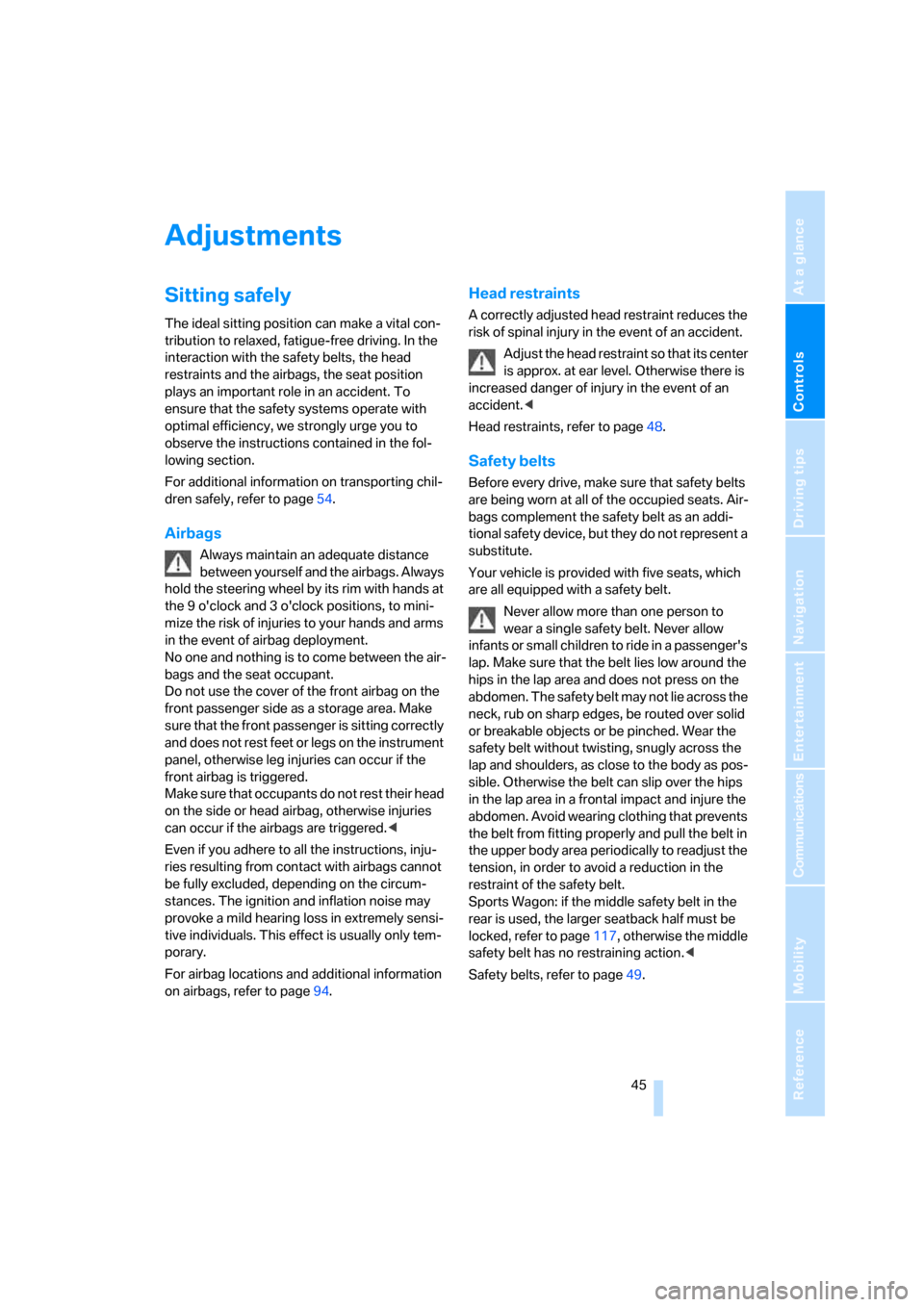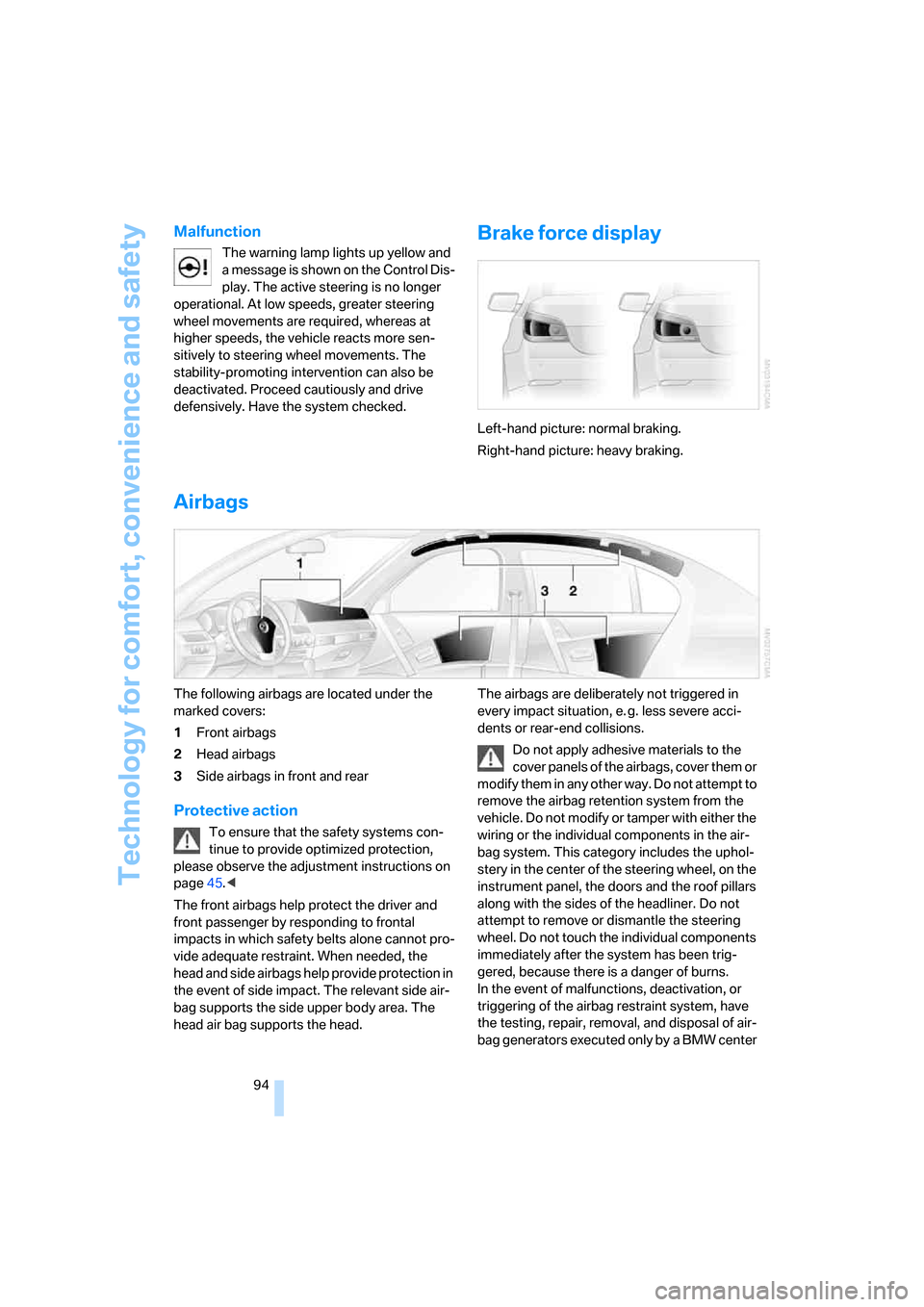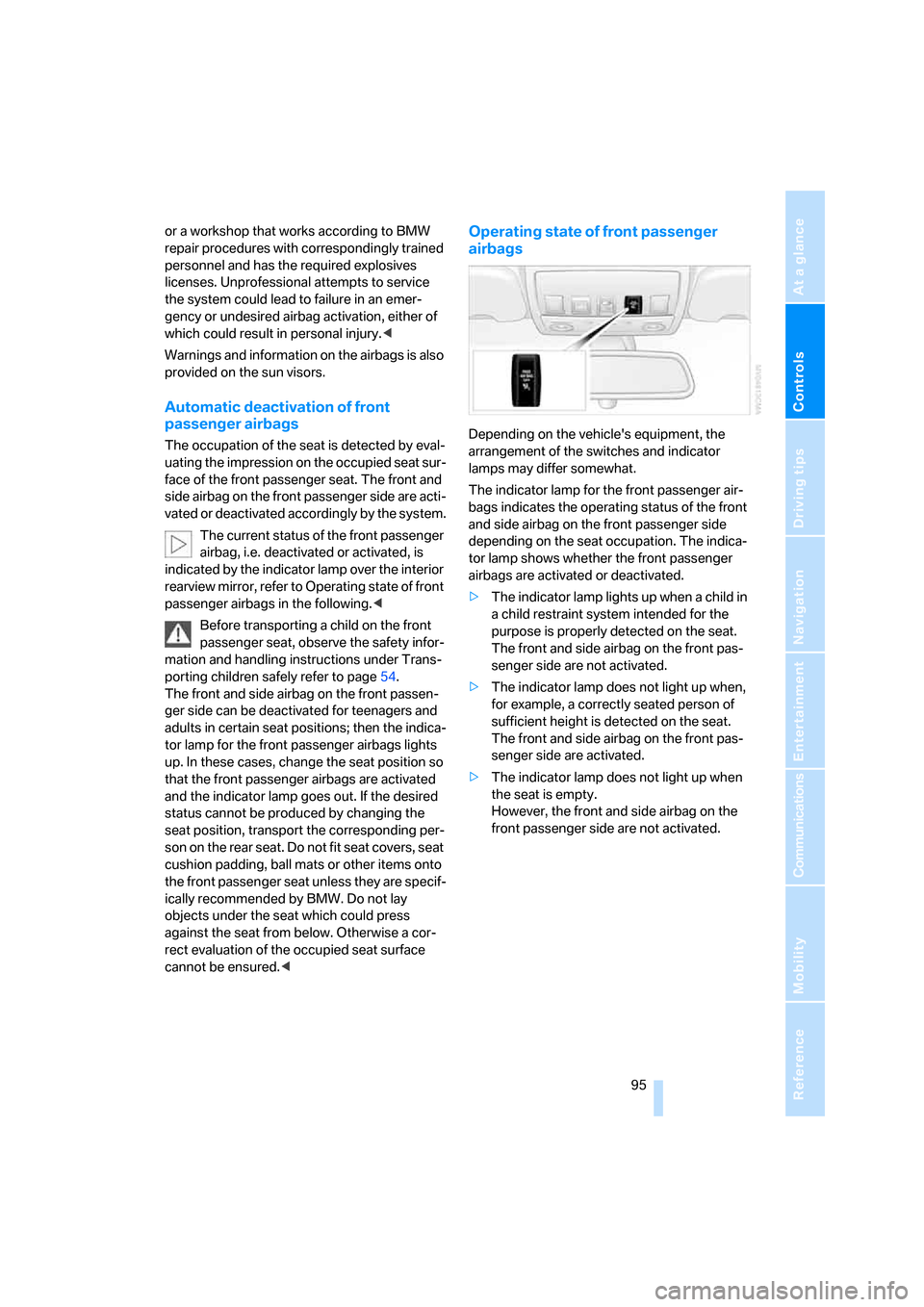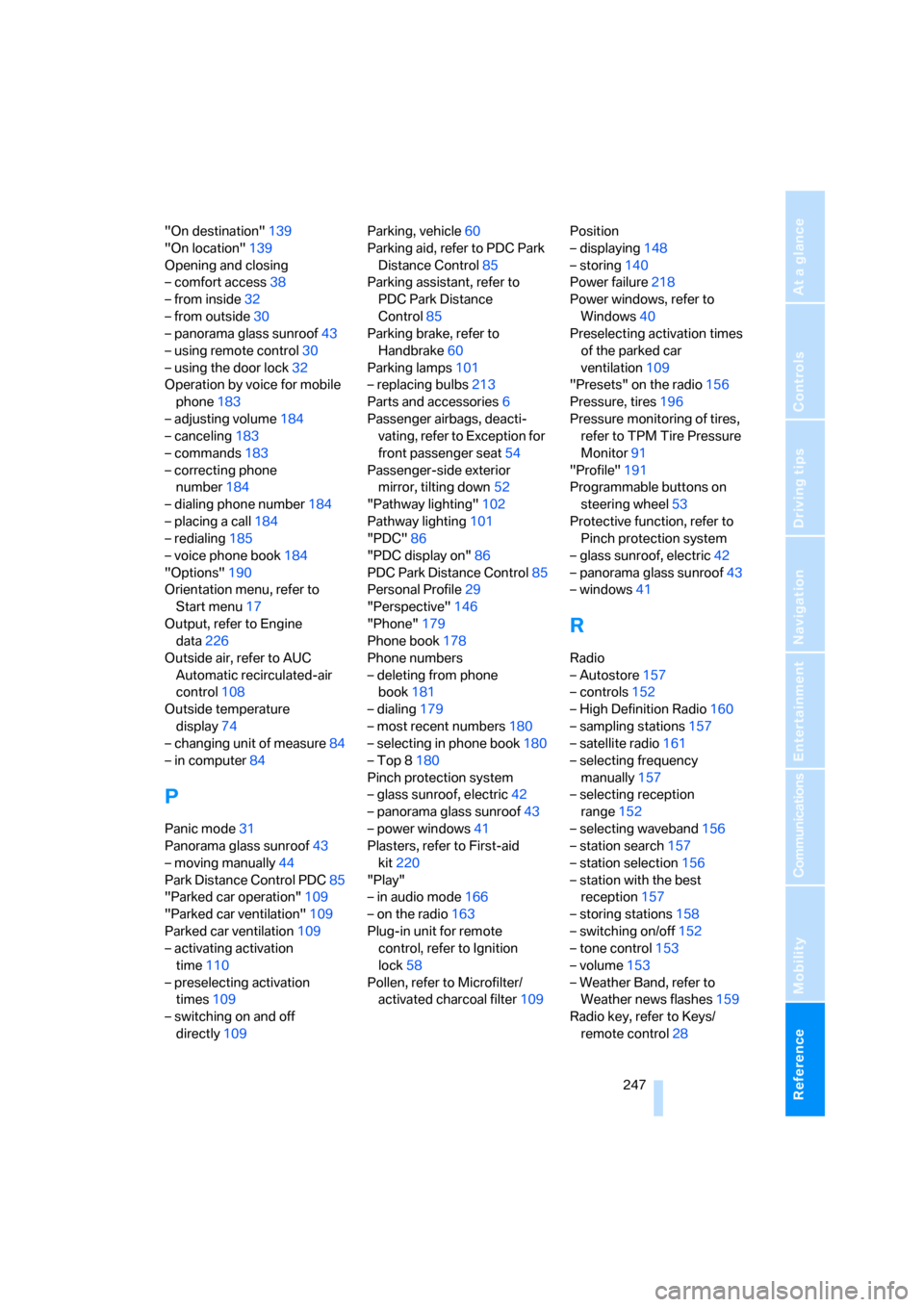2006 BMW 530XI TOURING passenger airbag
[x] Cancel search: passenger airbagPage 17 of 259

At a glance
15Reference
Controls
Driving tips
Communications
Navigation
Entertainment
Mobility
1Microphone for handsfree mode for
telephone
*
and for voice command system*22
2Reading lamps104
3Initiating
an emergency call219
4Interior lamps104
5Glass sunroof
*, electric41
Panorama glass sunroof
*43
6Passenger airbag status lamp95
7Control Display16
Displays for menu navigation
8Hazard warning flashers
9Central locking system32
10Automatic climate control105
11Changing
>radio station152
>track15212Ejecting
>navigation DVD
*132
>audio CD152
13Drive for navigation DVDs
*132
14Drive for audio CDs152
15Switching Entertainment sound output on/
off and adjusting volume152
17Controller16
Turn, press or move horizontally in four
directions
18Activating voice command system
*22
19Opening start menu on Control Display17
20Dynamic Driving Control
*62 Temperature setting, left/
right106
Automatic air distribution and
volume106
Cooling function107
AUC Automatic recirculated-air
control108
Recirculated-air mode108
Maximum cooling107
Residual heat mode108
Switching off automatic climate
control108
Air volume107
Defrosting windows and removing
condensation107
Rear window defroster105
16
Heated seats*50
Active seat ventilation
*51
Adjusting active backrest
width
*47
Active seat
*51
PDC Park Distance Control
*85
DTC Dynamic Traction Control87
Page 47 of 259

Controls
45Reference
At a glance
Driving tips
Communications
Navigation
Entertainment
Mobility
Adjustments
Sitting safely
The ideal sitting position can make a vital con-
tribution to relaxed, fatigue-free driving. In the
interaction with the safety belts, the head
restraints and the airbags, the seat position
plays an important role in an accident. To
ensure that the safety systems operate with
optimal efficiency, we strongly urge you to
observe the instructions contained in the fol-
lowing section.
For additional information on transporting chil-
dren safely, refer to page54.
Airbags
Always maintain an adequate distance
between yourself and the airbags. Always
hold the steering wheel by its rim with hands at
the 9 o'clock and 3 o'clock positions, to mini-
mize the risk of injuries to your hands and arms
in the event of airbag deployment.
No one and nothing is to come between the air-
bags and the seat occupant.
Do not use the cover of the front airbag on the
front passenger side as a storage area. Make
sure that the front passenger is sitting correctly
and does not rest feet or legs on the instrument
panel, otherwise leg injuries can occur if the
front airbag is triggered.
Make sure that occupants do not rest their head
on the side or head airbag, otherwise injuries
can occur if the airbags are triggered.<
Even if you adhere to all the instructions, inju-
ries resulting from contact with airbags cannot
be fully excluded, depending on the circum-
stances. The ignition and inflation noise may
provoke a mild hearing loss in extremely sensi-
tive individuals. This effect is usually only tem-
porary.
For airbag locations and additional information
on airbags, refer to page94.
Head restraints
A correctly adjusted head restraint reduces the
risk of spinal injury in the event of an accident.
Adjust the head restraint so that its center
is approx. at ear level. Otherwise there is
increased danger of injury in the event of an
accident.<
Head restraints, refer to page48.
Safety belts
Before every drive, make sure that safety belts
are being worn at all of the occupied seats. Air-
bags complement the safety belt as an addi-
tional safety device, but they do not represent a
substitute.
Your vehicle is provided with five seats, which
are all equipped with a safety belt.
Never allow more than one person to
wear a single safety belt. Never allow
infants or small children to ride in a passenger's
lap. Make sure that the belt lies low around the
hips in the lap area and does not press on the
abdomen. The safety belt may not lie across the
neck, rub on sharp edges, be routed over solid
or breakable objects or be pinched. Wear the
safety belt without twisting, snugly across the
lap and shoulders, as close to the body as pos-
sible. Otherwise the belt can slip over the hips
in the lap area in a frontal impact and injure the
abdomen. Avoid wearing clothing that prevents
the belt from fitting properly and pull the belt in
the upper body area periodically to readjust the
tension, in order to avoid a reduction in the
restraint of the safety belt.
Sports Wagon: if the middle safety belt in the
rear is used, the larger seatback half must be
locked, refer to page117, otherwise the middle
safety belt has no restraining action.<
Safety belts, refer to page49.
Page 56 of 259

Transporting children safely
54
Transporting children safely
The right place for children
Do not leave children unattended in the
vehicle, otherwise they could endanger
themselves and other persons, e.g. by opening
the doors.<
Children always in the rear
Accident research shows that the safest place
for children is on the back seat.
Children younger than 13 years of age or
with a height under 5 ft/150 cm may only
be transported in the rear in child restraint sys-
tems which correspond to the age, weight and
height of the child. Otherwise there is an
increased danger of injury in an accident.<
Children 13 years of age or older must wear a
safety belt as soon as a suitable child restraint
system can no longer be used due to their age,
size and weight.
With the exception of the driver's seat, all seats
in your BMW comply with the recommenda-
tions of the standard SAE J1819 for the safe
securing of child restraint systems in motor
vehicles.
Exception for front passenger seat
Should it be necessary to use a child
restraint system on the front passenger
seat, the front and side airbag on the passenger
side must be deactivated. Otherwise, there is
an increased risk of injury for the child if the air-
bags are triggered, even with a child restraint
s ystem. Your BMW center will be glad to advis e
you.<
For more information on automatic deactivation
of the front passenger airbags, refer to page95.
Installing child restraint
systems
Observe the child restraint system manu-
facturer's instructions for selection,
installation and use of the child restraint sys-
tems. Otherwise the degree of protection may
be reduced.<
Backrest width* on front passenger
seat
Before mounting a child restraint system
on the front passenger seat, the backrest
width adjustment must be open completely.
After mounting the child's seat, no memory
position may be called up and the active back-
rest width adjustment must be deactivated,
otherwise the stability of the child's seat on the
front passenger seat is limited.<
1.After unlocking the vehicle, place on the
front passenger seat and close the door to
call up the memory position.
2.Completely open the backrest width adjust-
ment, refer to page46.
3.Deactivate active backrest width adjust-
ment, refer to page47.
4.Install child's seat.
Child seat security
All rear safety belts and the safety belt for the
front passenger can be locked against pulling
out to secure child restraint systems.
Page 96 of 259

Technology for comfort, convenience and safety
94
Malfunction
The warning lamp lights up yellow and
a message is shown on the Control Dis-
play. The active steering is no longer
operational. At low speeds, greater steering
wheel movements are required, whereas at
higher speeds, the vehicle reacts more sen-
sitively to steering wheel movements. The
stability-promoting intervention can also be
deactivated. Proceed cautiously and drive
defensively. Have the system checked.
Brake force display
Left-hand picture: normal braking.
Right-hand picture: heavy braking.
Airbags
The following airbags are located under the
marked covers:
1Front airbags
2Head airbags
3Side airbags in front and rear
Protective action
To ensure that the safety systems con-
tinue to provide optimized protection,
please observe the adjustment instructions on
page45.<
The front airbags help protect the driver and
front passenger by responding to frontal
impacts in which safety belts alone cannot pro-
vide adequate restraint. When needed, the
head and side airbags help provide protection in
the event of side impact. The relevant side air-
bag supports the side upper body area. The
head air bag supports the head.The airbags are deliberately not triggered in
every impact situation, e. g. less severe acci-
dents or rear-end collisions.
Do not apply adhesive materials to the
cover panels of the airbags, cover them or
modify them in any other way. Do not attempt to
remove the airbag retention system from the
vehicle. Do not modify or tamper with either the
wiring or the individual components in the air-
bag system. This category includes the uphol-
stery in the center of the steering wheel, on the
instrument panel, the doors and the roof pillars
along with the sides of the headliner. Do not
attempt to remove or dismantle the steering
wheel. Do not touch the individual components
immediately after the system has been trig-
gered, because there is a danger of burns.
In the event of malfunctions, deactivation, or
triggering of the airbag restraint system, have
the testing, repair, removal, and disposal of air-
bag generators executed only by a BMW center
Page 97 of 259

Controls
95Reference
At a glance
Driving tips
Communications
Navigation
Entertainment
Mobility
or a workshop that works according to BMW
repair procedures with correspondingly trained
personnel and has the required explosives
licenses. Unprofessional attempts to service
the system could lead to failure in an emer-
gency or undesired airbag activation, either of
which could result in personal injury.<
Warnings and information on the airbags is also
provided on the sun visors.
Automatic deactivation of front
passenger airbags
The occupation of the seat is detected by eval-
uating the impression on the occupied seat sur-
face of the front passenger seat. The front and
side airbag on the front passenger side are acti-
vated or deactivated accordingly by the system.
The current status of the front passenger
airbag, i.e. deactivated or activated, is
indicated by the indicator lamp over the interior
rearview mirror, refer to Operating state of front
passenger airbags in the following.<
Before transporting a child on the front
passenger seat, observe the safety infor-
mation and handling instructions under Trans-
porting children safely refer to page54.
The front and side airbag on the front passen-
ger side can be deactivated for teenagers and
adults in certain seat positions; then the indica-
tor lamp for the front passenger airbags lights
up. In these cases, change the seat position so
that the front passenger airbags are activated
and the indicator lamp goes out. If the desired
status cannot be produced by changing the
seat position, transport the corresponding per-
son on the rear seat. Do not fit seat covers, seat
cushion padding, ball mats or other items onto
the front passenger seat unless they are specif-
ically recommended by BMW. Do not lay
objects under the seat which could press
against the seat from below. Otherwise a cor-
rect evaluation of the occupied seat surface
cannot be ensured.<
Operating state of front passenger
airbags
Depending on the vehicle's equipment, the
arrangement of the switches and indicator
lamps may differ somewhat.
The indicator lamp for the front passenger air-
bags indicates the operating status of the front
and side airbag on the front passenger side
depending on the seat occupation. The indica-
tor lamp shows whether the front passenger
airbags are activated or deactivated.
>The indicator lamp lights up when a child in
a child restraint system intended for the
purpose is properly detected on the seat.
The front and side airbag on the front pas-
senger side are not activated.
>The indicator lamp does not light up when,
for example, a correctly seated person of
sufficient height is detected on the seat.
The front and side airbag on the front pas-
senger side are activated.
>The indicator lamp does not light up when
the seat is empty.
However, the front and side airbag on the
front passenger side are not activated.
Page 244 of 259

Everything from A to Z
242 Engine starting, refer to
Starting engine59
"Enter address"134,140
Entering destination via town/
city name134
Entering the
address133,136
Entering the intersection135
Entering town/city for
navigation134
Entering zip code for
navigation135
"Entertainment"152
"Entertainment
settings"153,160
Entertainment sound output
on/off153
Entry map for destination137
"Equalizer", refer to Tone
control155
Equalizer, refer to Tone
control155
"ESN"162
ESP Electronic Stability
Program, refer to DSC
Dynamic Stability
Control86
Event Data Recorders210
Exhaust system, refer to Hot
exhaust system124
Exterior mirrors51
– automatic dimming
feature125
– automatic heating51
– folding in and out51
– tilting down passenger-side
exterior mirror52
External audio
device114,171
Eye for tow-starting and
towing, refer to Tow
fitting221
F
"Fader", refer to Tone
control154
Fader, refer to Tone
control154Failure messages, refer to
Check Control79
False alarm, refer to Avoiding
unintentional alarms38
Fastening safety belts, refer to
Safety belts49
– warning lamp49
Fastest route for
navigation142
"Fast route" for
navigation143
"Favorites" calling up with
radio159
First aid, refer to First-aid
kit220
First-aid kit220
Flashing during locking/
unlocking, refer to Setting
confirmation signals31
Flashlight, refer to
Rechargeable flashlight113
Flat tire
– changing wheels215
– compact wheel216
– Flat Tire Monitor89,90
– run-flat tires90,93,201
– TPM Tire Pressure
Monitor91
Flat Tire Monitor89
– false alarms90
– initializing system90
– show chains203
– system limits90
– warning lamp90
Flat tires, refer to Tire
condition201
"FM", reception
range152,156
FM, waveband156
Fog lamps104
– indicator lamp13,104
Folding rear seat
back116,117
Fold-over rear seat
back116,117
Footbrake, refer to Braking
safely125
Footwell lamps104Forward, fast
– CD changer
169
– CD player169
For your own safety5
4-wheel drive system, refer to
xDrive87
Freeway, refer to Route
criteria142
Front airbags94
Front armrest, refer to Center
armrest, front113
Front passenger airbags,
deactivating95
Front seat adjustment46
"FTM"90
FTM, refer to Flat Tire
Monitor89
Fuel195
– capacity230
– display75
– high-quality brands195
– quality195
– specifications195
Fuel clock, refer to Fuel
gauge75
Fuel consumption display,
computer, average fuel
consumption75
Fuel display, refer to Fuel
gauge75
Fuel filler door194
– releasing in the event of
electrical malfunction194
"Full screen" with BMW Night
Vision100
Fuses218
G
Garage door opener, refer to
Integrated universal remote
control111
Gasoline, refer to Required
fuel195
Gasoline display, refer to Fuel
gauge75
Page 249 of 259

Reference 247
At a glance
Controls
Driving tips
Communications
Navigation
Entertainment
Mobility
"On destination"139
"On location"139
Opening and closing
– comfort access38
– from inside32
– from outside30
– panorama glass sunroof43
– using remote control30
– using the door lock32
Operation by voice for mobile
phone183
– adjusting volume184
– canceling183
– commands183
– correcting phone
number184
– dialing phone number184
– placing a call184
– redialing185
– voice phone book184
"Options"190
Orientation menu, refer to
Start menu17
Output, refer to Engine
data226
Outside air, refer to AUC
Automatic recirculated-air
control108
Outside temperature
display74
– changing unit of measure84
– in computer84
P
Panic mode31
Panorama glass sunroof43
– moving manually44
Park Distance Control PDC85
"Parked car operation"109
"Parked car ventilation"109
Parked car ventilation109
– activating activation
time110
– preselecting activation
times109
– switching on and off
directly109Parking, vehicle60
Parking aid, refer to PDC Park
Distance Control85
Parking assistant, refer to
PDC Park Distance
Control85
Parking brake, refer to
Handbrake60
Parking lamps101
– replacing bulbs213
Parts and accessories6
Passenger airbags, deacti-
vating, refer to Exception for
front passenger seat54
Passenger-side exterior
mirror, tilting down52
"Pathway lighting"102
Pathway lighting101
"PDC"86
"PDC display on"86
PDC Park Distance Control85
Personal Profile29
"Perspective"146
"Phone"179
Phone book178
Phone numbers
– deleting from phone
book181
– dialing179
– most recent numbers180
– selecting in phone book180
– Top 8180
Pinch protection system
– glass sunroof, electric42
– panorama glass sunroof43
– power windows41
Plasters, refer to First-aid
kit220
"Play"
– in audio mode166
– on the radio163
Plug-in unit for remote
control, refer to Ignition
lock58
Pollen, refer to Microfilter/
activated charcoal filter109Position
– displaying148
– storing140
Power failure218
Power windows, refer to
Windows40
Preselecting activation times
of the parked car
ventilation109
"Presets" on the radio156
Pressure, tires196
Pressure monitoring of tires,
refer to TPM Tire Pressure
Monitor91
"Profile"191
Programmable buttons on
steering wheel53
Protective function, refer to
Pinch protection system
– glass sunroof, electric42
– panorama glass sunroof43
– windows41
R
Radio
– Autostore157
– controls152
– High Definition Radio160
– sampling stations157
– satellite radio161
– selecting frequency
manually157
– selecting reception
range152
– selecting waveband156
– station search157
– station selection156
– station with the best
reception157
– storing stations158
– switching on/off152
– tone control153
– volume153
– Weather Band, refer to
Weather news flashes159
Radio key, refer to Keys/
remote control28